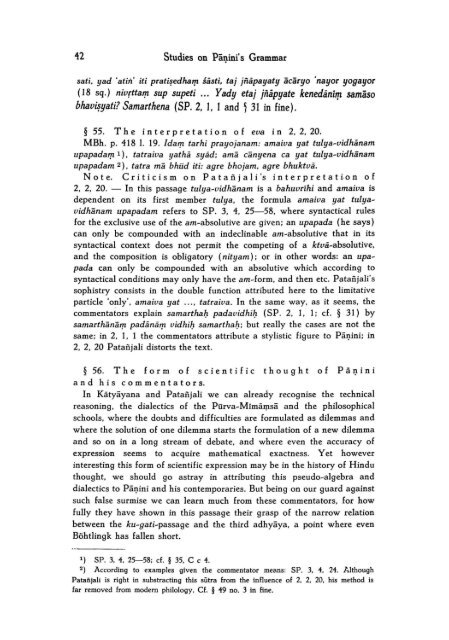Studies on Panini's grammar - DWC
Studies on Panini's grammar - DWC
Studies on Panini's grammar - DWC
You also want an ePaper? Increase the reach of your titles
YUMPU automatically turns print PDFs into web optimized ePapers that Google loves.
42 <str<strong>on</strong>g>Studies</str<strong>on</strong>g> <strong>on</strong> Pä~ini' s Grammar<br />
sati, yad 'atiTi' iti prati~edhaT[l<br />
sasti, taj jfiäpayaty äcäryo 'nayor yogayor<br />
(18 sq.) nivrttaf!l sup supeti ... Yady etaj jnäpyate kenedäni1fl samäso<br />
bhav4gati? Samarthena (SP. 2. 1. 1 and ~ 31 in fine).<br />
§ 55. Th e int e r pre t a t i<strong>on</strong> 0 f eva in 2, 2, 20.<br />
MBh. p. 418 I. 19. Ida,!! tarhi prayojanam: amaiva yat tulya~vidhanam<br />
upapadaT[ll) , tatraiva yatha syäd; amä cänyena ca yat tulya~vidhänam<br />
upapadam 2), tatra mä bhïid iti: agre bhojam, agre bhuktvä.<br />
Not e. Cri tic i s m 0 n Pat a ii j a I i 's int e r pre t a t i· 0 n 0 f<br />
2, 2, 20. - In this passage tulya~vidhänam is a bahuvrïhi and amaiva is<br />
dependent <strong>on</strong> its first member tulya, the formula amaiva yat tulya~<br />
vidhänam upapadam refers to SP. 3, 4, 25-58, wh ere syntactical rules<br />
for the exclusive use of the am~absolutive are given; an upapada (he says)<br />
can <strong>on</strong>ly becompounded with an indeclinable am ~absolutive that in its<br />
syntactical c<strong>on</strong>text does not permit the competing of a ktvä~absolutive,<br />
and the compositi<strong>on</strong> is obligatory (nityam); or in other words: an upa~<br />
pada can <strong>on</strong>ly be compounded with an absolutive which according to<br />
syntactical c<strong>on</strong>diti<strong>on</strong>s may <strong>on</strong>ly have the am~form , and then etc. Pataiijali' s<br />
sophistry c<strong>on</strong>sists in the double functi<strong>on</strong> attributed here to the limitative<br />
particle '<strong>on</strong>ly', amaiva yat .. ., tatraiva. In the same way, as it seems, the<br />
commentators explain samartha/J padavidhi/J (SP. 2, 1. 1; cf. § 31) by<br />
samarthänäT[l padänäT[l vidhi/J samartha/J; but really the cases are not the<br />
same; in 2, 1, 1 the commentators attribute a stylistic figure to PäJ?ini; in<br />
2, 2, 20 Pataiijali distorts the text.<br />
§ 56. T hef 0 r mof s c i ent i f i c t hou 9 h tof P ä J? i n i<br />
a n d h i s c 0 mme n t a tor s.<br />
In Kätyäyana and Pataiijali we can already recognise the technical<br />
reas<strong>on</strong>ing, the dialectics of the Pi1rva~MimäIp.sä and the philosophical<br />
schools, where the doubts and difficulties are formulated as dilemmas and<br />
where the soluti<strong>on</strong> of <strong>on</strong>e dilemma starts the formulati<strong>on</strong> of a new dilemma<br />
and so <strong>on</strong> in a l<strong>on</strong>g stream of debate, and where even the accuracy of<br />
expressi<strong>on</strong> seems to acquire mathematical exactness. Yet however<br />
interesting this form of scientific expressi<strong>on</strong> may be in the history of Hindu<br />
thought, we should go astray in attributing this pseudo ~ algebra and<br />
dialectics to PäJ?ini and his c<strong>on</strong>temporaries. But being <strong>on</strong> our guard against<br />
such false surmise we can learn much from these commentators, for how<br />
fully they have shown in th is passage their grasp of the narrow relati<strong>on</strong><br />
between the ku~gati~passage and the third adhyäya, a point where even<br />
Böhtlingk has fallen short.<br />
1) SP. 3, 4. 25-58; cf. § 35. C c 4.<br />
2) According to examples given the commentator means: SP. 3. 4, 24. Although<br />
Pataiijali is right in substracting this sütra from the influence of 2, 2, 20, his method is<br />
far removed from modem philology. Cf. § 49 no. 3 in fine.
















